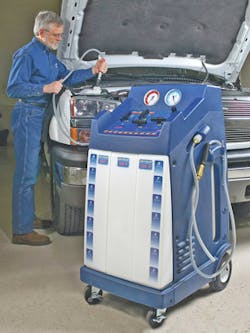From brake flush to coolant, and transmission to power steering fluid exchange systems, every shop owner is looking for something specific. While some are looking to enhance the quality of their full-service exchanges, others need something to boost their times. No matter what kind of shop you're catering to, there's something for everyone that is sure to offer an impressive return on their investment.
The moment a mobile dealer wraps his head around the many types fluid exchange equipment available, he becomes an invaluable tool for the shop owners and technicians along his route.
In hot pursuit of maintenance dollars
A major point of interest for shop owners is how to keep their full-service dollars flowing.
"Shops are fighting for that maintenance dollar, and trying not to let it go back to the dealership if it can be avoided," said Jim O'Hara, director of marketing at Clore Automotive.
"Of course, they want more of their customers' wallets, and preventative maintenance is a great way to get it," said O'Hara.
Now, more than ever, automotive repair businesses large and small are interested in machines that will allow them to add a repeatable, high-quality service.
"The biggest things people ask about are reliability, who else has the unit and some type of history in regards to its performance in the field," said Frank Casale, director of sales and marketing at Flo Dynamics. "Price is always an issue, and then of course how it performs, and how easy it is to operate."
Fortunately, many fluid exchange machines are push-button operated, with audible alerts when the service is complete.
"Easy operation functions and equipment that offers several different service options in one machine" are the biggest trends in the industry, according to Amanda Summers, RTI's marketing manager, communications and research.
The main exchange
So what kinds of equipment are shops buying? Coolant, and transmission and brake fluid exchangers are three of the most common services taking place in bays.
When it comes to transmission fluid exchanges, "our most popular machine has the ability to exchange fluid through the dipstick tube or inline connection," said Casale.
"The biggest thing there is speed and ease of use.
"We have [these machines] in dealerships, we have them in full-service and we have them in quick lubes."
Transmission fluid exchangers with dipstick mode run about $4,000 and perform multiple services.
For coolant exchangers, O'Hara advised that some machines do true flushing and not simply vacuum extraction, like multi-tube machines do. The purpose of this is to offer a complete flush with a much higher percentage of fluid exchanged.
"This approach is the right way to do the job and increase the use of long life coolants in the marketplace," said O'Hara. He also claims this approach is consistent with cooling system service on today's vehicles and the frequent need to use chemical cleaners to bring the system back to proper operation.
"Chemical cleaners are best used in conjunction with a true flushing service to ensure the cleaner is completely removed from the vehicle system," said O'Hara.
Coolant machines that offer in-shop recycling are also in the works, along with a machine that's a straight drain flush-and-fill.
These flushing machines, according to O'Hara, are the most popular item requested by mechanics and run about $2,000.
Don't stop at brakes
Brake fluid sales in the industry are slow, but improving. It's law in many European countries to exchange brake
fluid annually, and this same practice is catching on in
the U.S.
"Brake fluid itself draws moisture to it, and once it is saturated with moisture, it becomes inefficient," said Bill Blumenstine, automotive division national sales manager at Ritchie Engineering. "So [when you] change the fluid on the regular intervals, brake performance improves.
"A soft pedal means you have air and/or moisture in the line. By doing a proper flush or exchange, those two things are eliminated."
And A/C equipment continues to be a top-seller in fluid exchange, with the equipment changing dramatically to meet the revised SAE J2788 standards.
"A few years ago, it was typical to see a three, 3.5-pound air conditioning charge," said Blumenstine. "It's now a pound, and in 2008 they're going to go below that.
The old specification was plus/minus an ounce of refrigerant, and the new specification is plus/minus a half ounce."
A powerful payback
Due to an ongoing demand for exchange services, and also because of this equipment's general affordability, payoff can come quickly — often within a few months.
"We put a machine in the Valvoline distributor for evaluation," said Casale, "and he ran over 3,000 quarts through the machine in about a three-month period. If you equate that to dollars, he made about $18,000 in sales on that one piece of equipment in three months.
"That's out of the ordinary, but there's some huge potential," Casale said. "You figure a $4,000 piece of equipment is going to generate about $78,000 in a years' time.
I'm not sure which shop wouldn't sign up today."
Payoff also depends on the activity of the shop and how they're promoting the service.
Sales breed sales
An impressive ROI doesn't stop at the exchange service, either.
"A lot of the shops have gone to this type of service and are expanding their offerings for the end user," said Blumenstine. "Just about everybody is doing brake service now, with the exception of perhaps quick lubes."
"[Tech shops] are not only going to increase their revenue based on offering this service; they're going to get a lot of add-on services," said O'Hara.
It's not uncommon for these add-on services to present themselves during a routine exchange process.
"We found that shops that bring in cooling system service equipment not only increase their revenue from the service, but increase their repair ticket and parts sales related to the cooling system because they're diagnosing problematic areas of the cooling system. It creates opportunities for them to sell more thermostats, more radiator caps, more repair … because they're in a better position to know what that system needs. That's a huge selling point for the mobile."
Come armed with a solution
With sometimes more than 10 or 12 different choices in every category of exchange equipment, distributors must do their homework before they're qualified to make a valuable suggestion to their customers.
They can start by asking questions like: "Are they selling ease-of-use and quick service? Then vacuum extraction may make a lot of sense. Or, if they want to sell a complete thorough process, true flushing [may be] the way to go," said O'Hara.
"And [distributors should] be armed with that information before the selling situation occurs," O'Hara said.
"Because you can't find out the customer needs something and then scramble to figure out what to offer them. If you're educated and armed, you can sell them the right piece of equipment.
"The tool dealer has to assess [the situation] to determine what is best to present to that particular customer, because they're going to have to keep coming in the shop for a number of years," O'Hara said. "If they sell a wrong piece of equipment for that particular shop, they're going to hear about it every time they're in there. It's not worth it to not be educated."
Get in on the profit
With many full-service shops and quick lubes vying to perform fluid exchange services, and because both are looking to keep their business away from dealerships, it is a competitive market where all parties are looking for the best edge.
Revenue is almost guaranteed when a shop owner purchases the right piece of equipment. It may take a little time and some product research, but when a mobile dealer speaks fluid exchange fluently, he can give shop owners what they want.
Sources:
Jim O'Hara, Clore Automotive.
www.cloreautomotive.com
Amanda Summers, RTI Technologies.
www.rtitech.com
Frank Casale, Flo Dynamics.
www.flodynamics.com
Bill Blumenstine, Ritchie Engineering.
www.yellowjacket.com
4 pictures


